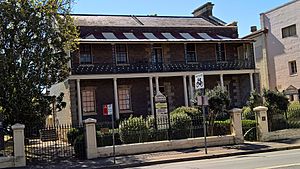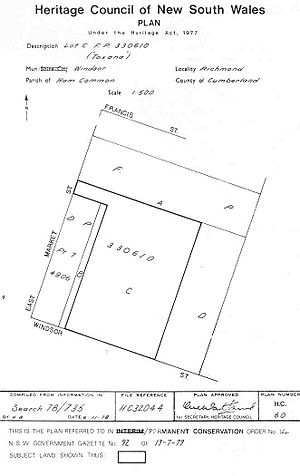Toxana facts for kids
Quick facts for kids Toxana |
|
|---|---|

Toxana, 157 Windsor Street, Richmond, New South Wales
|
|
| Location | 157 Windsor Street, Richmond, City of Hawkesbury, New South Wales, Australia |
| Built | 1843–1844 |
| Owner | Edds Family Superannuation Fund |
| Official name: Toxana | |
| Type | state heritage (built) |
| Designated | 2 April 1999 |
| Reference no. | 14 |
| Type | Town House |
| Category | Residential buildings (private) |
| Builders | James Melville (bricks); George Marlin (carpentry) |
| Lua error in Module:Location_map at line 420: attempt to index field 'wikibase' (a nil value). | |
Toxana is a historic house located at 147 Windsor Street in Richmond, Australia. It is a special building because it was once the first home of the Hawkesbury Agricultural College from 1891 to 1896. This important building was added to the New South Wales State Heritage Register on April 2, 1999, which means it is protected for future generations.
Contents
A Look Back at Toxana's History
The First People of the Land
The land around Toxana, in the lower Hawkesbury area, was originally home to the Dharug people. The nearby Nepean River and South Creek were very important for them. These waterways provided plenty of food and were used for travel. The Dharug and Darkinjung people called the river "Deerubbin."
Early European Settlement
In 1789, Governor Arthur Phillip explored this area. He was looking for good land to farm. He discovered and named the Hawkesbury River. European settlers started living here by 1794. This region was very important for the early growth of the colony.
The area, first called Green Hills, had fertile land. It helped feed the colony during tough times. However, the river often flooded, which caused problems for farmers.
The Bowman Family and Richmond
John Bowman (1763-1825) arrived in New South Wales in 1798. He was a free settler from England. He started a farm called "Archerfield" in Richmond. He received 100 acres of land in 1799.
John Bowman supported the free settlers in the Hawkesbury. He stood against unfair practices by the military. He also supported Governors William Bligh and Lachlan Macquarie. His efforts helped small settlers get more support.
After Governor Bligh was removed from power, Bowman and other settlers continued to support him. They sent a letter to England in 1809. This letter stated they were not involved in the rebellion against Bligh.
Governor Macquarie's Influence
Governor Macquarie took over in 1810. Under his leadership, the colony grew stronger. He started many building projects. He also improved roads and public services. In December 1810, he created five new towns in the Hawkesbury Region. Richmond was one of these "Macquarie Towns." This made Richmond a more permanent place. It gained streets, public buildings, and a town square.
Once the colony was stable, John Bowman focused on farming. Governor Macquarie promised him land where Toxana now stands. In 1821, John Bowman started building a house on Richmond's main street. He passed away in 1825. His son, George Bowman, inherited the house. George became a farmer and later a politician.
John Bowman's youngest son, William Bowman, also played a big role. In the 1830s, he helped bring more free immigrants to the colony. He even paid for 12 married couples to travel from London to Sydney.
Building Toxana
William Bowman was granted the land for Toxana around the 1830s. Records from 1836 show other buildings and a garden on the site before Toxana was built. Toxana itself was likely built between 1843 and 1844.
There was some debate about who built Toxana. It seems that James Melville did the brickwork. George Marlin and his three sons did the carpentry. They worked together to build this large house for William Bowman.
Toxana was a grand town house. It was built during a time when the colony was doing very well. It showed the hopeful spirit of that time. William Bowman was a successful farmer and politician. He owned other properties and was involved in growing wine.
William Bowman died in 1874. His wife, Elizabeth, lived in Toxana until her death in 1885. The property then passed through a few owners. Eventually, in 1886, the Reverend James Cameron bought Toxana. He later became a very important leader in the Presbyterian Church in Australia.
Toxana as a College
In 1891, Toxana became very important for education. The new Hawkesbury Agricultural College leased it. It was used as a temporary home for its first students. About 25 students moved in on March 10, 1891. The College officially opened on March 16, 1891.
Students ate meals in the basement of Toxana. Lectures were held in a room on the first floor. The rest of the house was used for student bedrooms. The college's horses were kept in stables behind Toxana. There was also a small dairy for the college's bull.
In 1896, all the students moved to a new, specially built college campus. This new campus was located just outside Richmond. The College taught young farmers about science and practical farming skills.
Changes Over Time
Toxana saw some changes while it was a college. In 1892, a strong wind blew down the upper verandah. Later that year, Richmond got a piped water supply. Toxana then received water directly, instead of from roof tanks. A bee farm was even set up in the garden behind Toxana for a few years.
After Reverend Cameron passed away in 1905, Toxana was leased to the 3rd Australian Infantry Regiment. It was later divided into flats for rent.
During World War II in 1942, local ministers wanted to lease Toxana. They hoped to use it as a service club for soldiers. However, the plan was not carried out.
Restoration and Heritage Listing
In 1978, the Windsor Municipal Council bought Toxana for $75,000. They spent a lot of money to restore it. The Australian Government also helped with funding. This restoration work helped bring the building back to its original beauty.
As part of the restoration, the front garden was changed. Some of the original front fence was moved or replaced. A large jacaranda tree in the front garden was kept.
Toxana was given a Permanent Conservation Order in 1979. This order protects its historical value. It was also listed on the Register of the National Estate in 1980. Finally, on April 2, 1999, it was officially listed on the New South Wales State Heritage Register. This ensures Toxana will be preserved for many years to come.
What Toxana Looks Like
Toxana is a grand two-story house. It stands on Richmond's main street, close to the town center. It has a front garden set back from the street. A fence with stone pillars and iron railings surrounds the garden. At the back, there is a driveway and parking area.
The house has beautiful details from the Regency and Georgian styles. The first floor has iron railings and open iron columns. The ground floor has round wooden columns that get narrower at the top. The house is built high above the ground, giving it a very grand entrance. It is made of brick with special sandstone blocks at the corners and around the windows. The front door is also surrounded by heavy stonework.
Why Toxana is Important
Toxana was built around 1840 for William Bowman. He was elected to the first Parliament of New South Wales in 1843. Toxana is one of the most important houses in the Richmond area. It has strong links to history and shows amazing Regency and Georgian design.
The house is a large two-story building. It features iron railings and open iron columns on the first floor. The ground floor has tapered round timber columns. The house is raised high above the ground, with a very noticeable entrance. It is built from face brick with sandstone blocks and heavy stonework around the front door.
Toxana was officially listed on the New South Wales State Heritage Register on April 2, 1999.
See also
- Hawkesbury Agricultural College


